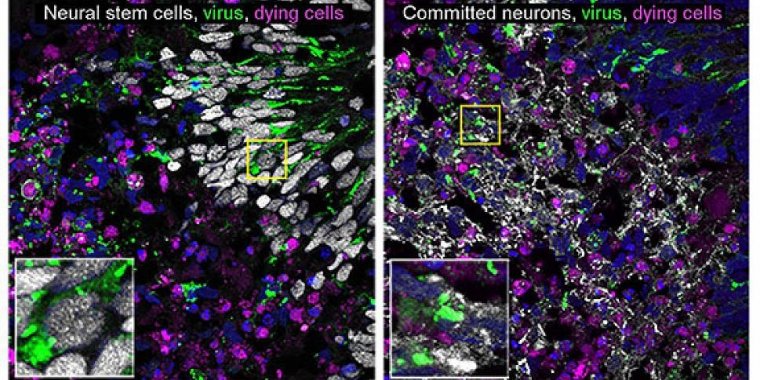| Health / Health News |
Cerebral organoid model provides clues about how to prevent virus-induced brain cell death
Scientists have determined that La Crosse virus (LACV), which can cause inflammation of the brain in children, affects brain cells differently depending on their developmental stage. Neurons—the primary brain cells of the central nervous system—evolve from neural stem cells and during development “commit” to becoming neurons. A new National Institutes of Health study shows that uncommitted neural stems cells generally survive LACV infection, while LACV often kills neurons. The study also shows that neurons infected by LACV can be rescued by interferon, a powerful antiviral protein.

These images taken from LACV-infected cerebral organoids show infected cells (green) and cells that are dying from infection (magenta). The left image also shows neural stem cells (white) that have the potential to become neurons; these cells are rarely dying. In contrast, the image on the right shows committed neurons (white), many of which are shown to be dying. Photo: NIAID
LACV is spread by mosquitoes and was first identified in the early 1960s. Most infections in people are mild but the virus sometimes—particularly in children—enters the brain, infects neurons and causes disease ranging from learning and memory difficulties to paralysis, seizures and death.
The NIH scientists, from the National Institute of Allergy and Infectious Diseases Rocky Mountain Laboratories in Hamilton, Montana, used cerebral organoids to model how LACV infects the human brain.
Cerebral organoids are small spheres of human brain cells ranging in size from that of a poppy seed to a small pea. Importantly, cerebral organoids contain different neuronal cell types, which allowed the investigators to assess the sensitivity of neural stem cells and neurons to LACV infection.
After infecting cerebral organoids with LACV, the researchers observed that the virus was more likely to kill neurons, and they also found that the immune response to the virus was weaker in those cells than in neural stem cells. The largest observed difference was in genes activated by interferon, which are important in protecting cells from viruses.
The investigators then repeated the experiment, but this time treated the cerebral organoids with interferon 24 hours after infecting them. The therapy successfully protected neurons from virus-induced death. (National Institutes of Health)
YOU MAY ALSO LIKE





